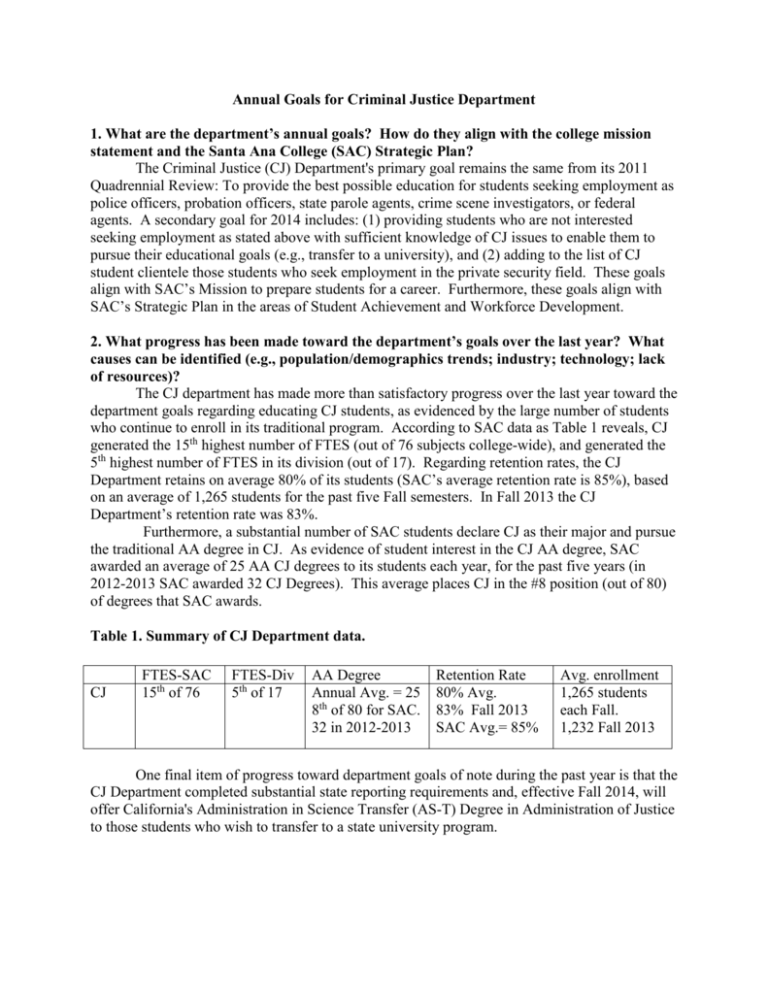Annual Goals for Criminal Justice Department
advertisement

Annual Goals for Criminal Justice Department 1. What are the department’s annual goals? How do they align with the college mission statement and the Santa Ana College (SAC) Strategic Plan? The Criminal Justice (CJ) Department's primary goal remains the same from its 2011 Quadrennial Review: To provide the best possible education for students seeking employment as police officers, probation officers, state parole agents, crime scene investigators, or federal agents. A secondary goal for 2014 includes: (1) providing students who are not interested seeking employment as stated above with sufficient knowledge of CJ issues to enable them to pursue their educational goals (e.g., transfer to a university), and (2) adding to the list of CJ student clientele those students who seek employment in the private security field. These goals align with SAC’s Mission to prepare students for a career. Furthermore, these goals align with SAC’s Strategic Plan in the areas of Student Achievement and Workforce Development. 2. What progress has been made toward the department’s goals over the last year? What causes can be identified (e.g., population/demographics trends; industry; technology; lack of resources)? The CJ department has made more than satisfactory progress over the last year toward the department goals regarding educating CJ students, as evidenced by the large number of students who continue to enroll in its traditional program. According to SAC data as Table 1 reveals, CJ generated the 15th highest number of FTES (out of 76 subjects college-wide), and generated the 5th highest number of FTES in its division (out of 17). Regarding retention rates, the CJ Department retains on average 80% of its students (SAC’s average retention rate is 85%), based on an average of 1,265 students for the past five Fall semesters. In Fall 2013 the CJ Department’s retention rate was 83%. Furthermore, a substantial number of SAC students declare CJ as their major and pursue the traditional AA degree in CJ. As evidence of student interest in the CJ AA degree, SAC awarded an average of 25 AA CJ degrees to its students each year, for the past five years (in 2012-2013 SAC awarded 32 CJ Degrees). This average places CJ in the #8 position (out of 80) of degrees that SAC awards. Table 1. Summary of CJ Department data. CJ FTES-SAC 15th of 76 FTES-Div 5th of 17 AA Degree Annual Avg. = 25 8th of 80 for SAC. 32 in 2012-2013 Retention Rate 80% Avg. 83% Fall 2013 SAC Avg.= 85% Avg. enrollment 1,265 students each Fall. 1,232 Fall 2013 One final item of progress toward department goals of note during the past year is that the CJ Department completed substantial state reporting requirements and, effective Fall 2014, will offer California's Administration in Science Transfer (AS-T) Degree in Administration of Justice to those students who wish to transfer to a state university program. 3. What research has the department conducted? One of the two CJ department chairs is presently working on his PhD in the discipline of Psychology; his dissertation consists of an examination of emotional intelligence, decisionmaking style, and the level of exposure to criminal gang activity upon youth. This topic has significant relevance to the CJ Department program and the field of CJ. Additionally, several of CJ’s part-time faculty serve in supervisory and management capacities with CJ agencies that conduct substantial research into CJ topics, which the CJ part-time faculty use in teaching their courses to SAC students. 4. Do goals need to be restructured, eliminated, or pursued with different activities? Currently, the CJ Department goals as modified above are meeting the needs of SAC students. 5. What are the proposed goals for next year? (Include fiscal implications) The proposed goals for next year consist of re-examining the existing goals and making adjustments as necessary. Moreover, a goal for next year will consist of an evaluation of the first year of SAC’s offering of California's new AS-T Degree in CJ. There may be fiscal implications due to the impact of the AS-T Degree offering upon SAC’s traditional AA Degree in CJ, but it is too early to project.









